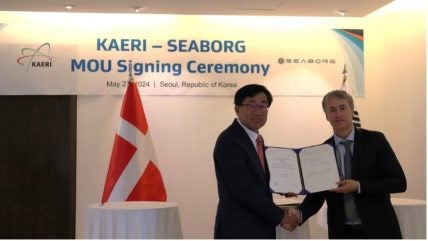
The Korea Atomic Energy Research Institute (KAERI) and Danish floating NPP developer Seaborg have signed a memorandum of understanding (MOU) on advancing nuclear technologies, in particular molten salt reactors. The MOU was signed at the Danish ambassador’s residence in Seoul by KAERI President Han Gyu Joo and Seaborg CEO Klaus Nyengaard.
Seaborg said the MOU “paves the way for both institutions to leverage their respective research and development expertise and infrastructure”. It added that they aimed “to create a synergistic relationship that will enhance their capabilities and drive forward innovations in nuclear technology”.
Seaborg’s design is for modular compact molten salt reactor (CMSR) power barges equipped with between two and eight 100 MWe CMSRs, with an operational life of 24 years. Instead of having solid fuel rods that need constant cooling, the CMSR’s fuel is mixed in a liquid salt that acts as a coolant, which means that it will simply shut down and solidify in case of emergency. However, the low-enriched fluoride fuel salt is not yet commercially available, so Seaborg announced the initial power barges will be fuelled with low-enriched uranium (LEU). Seaborg, founded in 2014, aims for commercial prototypes of its CMSR to be built in 2026 with commercial production of Power Barges beginning from 2028.
Seaborg has also signed a MOU with Kepco Nuclear Fuel and GS Engineering & Construction to collaborate on investigating the feasibility of developing an LEU fuel salt production facility in South Korea. In 2022, Samsung Heavy Industries (SHI) and Seaborg signed a memorandum of understanding to manufacture and sell turnkey power plants combining SHI’s ship-building expertise and Seaborg’s CMSR. It also covered the development of hydrogen production plants and ammonia plants.
In February 2023, nine South Korean organisations, including KAERI, signed an MoU to cooperate on the development and demonstration of ships and offshore systems powered with small modular reactors, and to jointly developing a molten salt reactor suitable for use in marine vessels. The signatories aim to demonstrate how SMRs can be used for navigation and to examine development of the interface between relevant marine systems and SMR propulsion technology, as well as the production of hydrogen using molten salt reactors.






